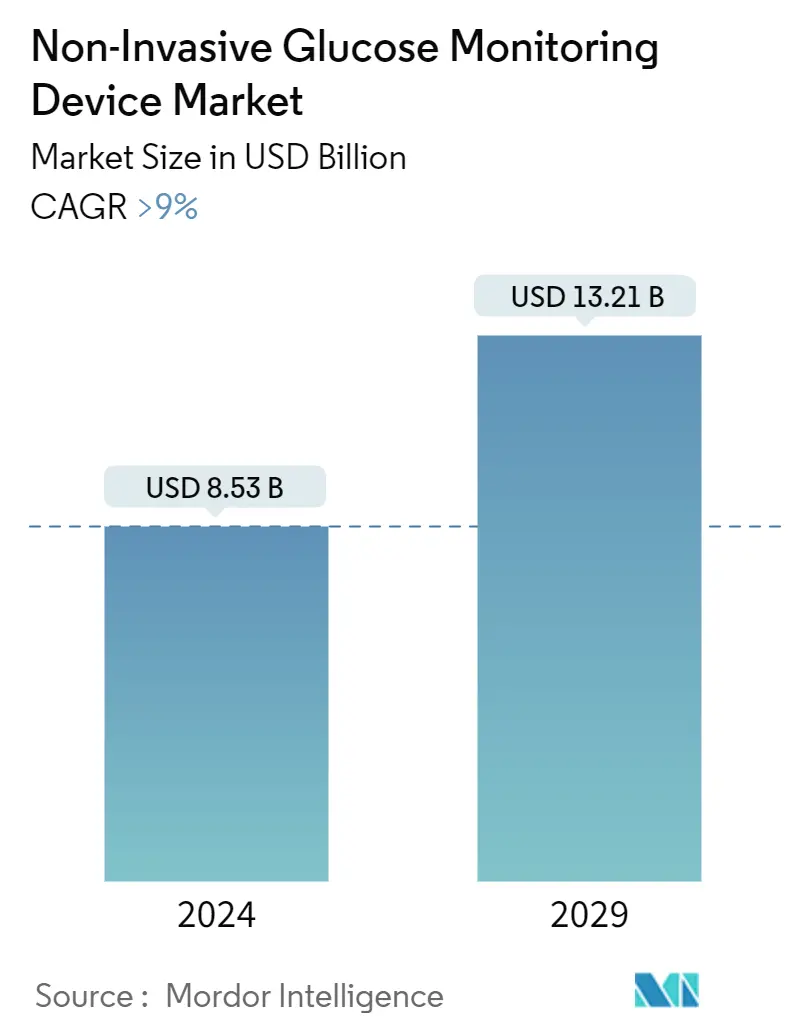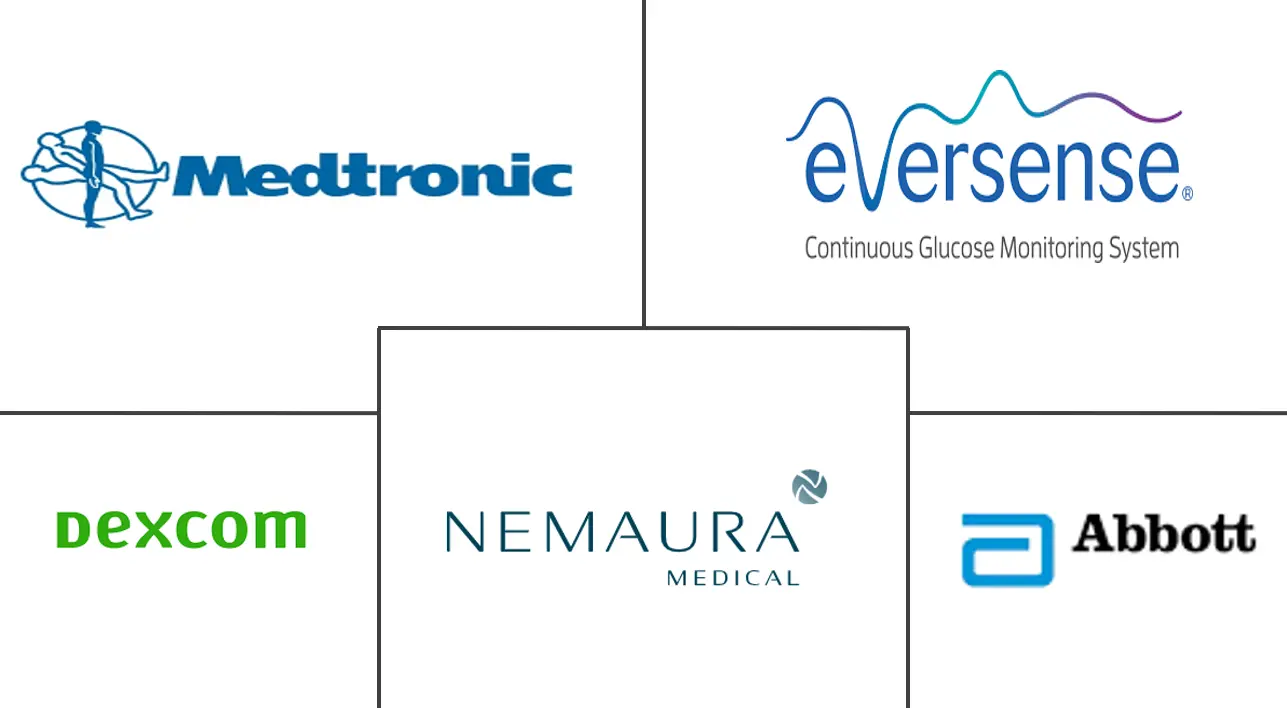Market Size of Non-Invasive Glucose Monitoring Device Industry

| Study Period | 2018-2029 |
| Market Size (2024) | USD 8.53 Billion |
| Market Size (2029) | USD 13.21 Billion |
| CAGR (2024 - 2029) | 9.00 % |
| Fastest Growing Market | Asia Pacific |
| Largest Market | North America |
Major Players
*Disclaimer: Major Players sorted in no particular order |
Non-Invasive Glucose Monitoring Device Market Analysis
The Non-Invasive Glucose Monitoring Device Market size is estimated at USD 8.53 billion in 2024, and is expected to reach USD 13.21 billion by 2029, growing at a CAGR of greater than 9% during the forecast period (2024-2029).
Non-invasive glucose meters represent devices that assess blood glucose levels without the need for blood extraction. This confers a notable benefit when compared to conventional glucose meters, as they necessitate a fingerstick to procure a blood sample. Non-invasive glucose meters are presently undergoing development, with numerous promising technologies currently under investigation.
Diabetes was recognized as a risk factor for numerous severe infections, particularly for the rapid progression and unfavorable prognosis of COVID-19. Consequently, individuals with diabetes needed heightened attention. This presented a significant clinical hurdle in managing diabetes during the pandemic period.
To mitigate the risk of coronavirus transmission, remote monitoring of glucose levels is imperative to deliver tailored home care. As a result, the advancement of personalized, continuous glucose monitoring (CGM) has garnered increased interest in effectively managing diabetes and preventing the spread of the virus. Therefore, in these unparalleled times, telemedicine intervention supporting CGM emerges as an ideal solution for diabetes management. It enables remote clinical consultations for diabetes patients through glucose self-monitoring, aided by personalized CGM devices. This approach not only maintains the effectiveness of diabetes care but also minimizes exposure to the virus among patients and residents, thereby contributing to global efforts against COVID-19.
Non-invasive glucose meters offer several benefits over traditional glucose meters, including the elimination of pain or discomfort. With no need for fingersticks, users can enjoy a painless and comfortable experience. Additionally, non-invasive glucose meters can be used more frequently since they don't require a blood sample, providing enhanced convenience. By offering more frequent glucose readings, non-invasive glucose meters can help individuals with diabetes achieve better glycemic control.
Certain obstacles must be overcome before non-invasive glucose meters can be embraced on a large scale despite their potential advantages. These obstacles include the fact that non-invasive glucose meters are not as precise as conventional glucose meters and can be influenced by factors such as skin temperature and humidity. Additionally, non-invasive glucose meters are usually more costly than traditional glucose meters.
Despite the obstacles, there exists considerable optimism regarding the prospects of non-invasive glucose meters in the future. Scientists persist in their efforts to innovate and create more precise and dependable technologies. With the progression of these technologies, it is anticipated that non-invasive glucose meters will likely become increasingly accessible and cost-effective.
Non-Invasive Glucose Monitoring Device Industry Segmentation
Non-invasive blood glucose monitoring, as its name suggests, pertains to the identification of human blood glucose levels without inflicting harm on human tissues.
The non-invasive glucose monitoring device market is segmented by type (wearable and handled), by end-user (hospitals, clinics, and home care/personal), and by geography (North America, Europe, Asia-Pacific, the Middle East, Africa, and Latin America).
The report offers the value (in USD) and volume (in Units) for the above segments.
| Type | |
| Wearable | |
| Non Wearable |
| By End User | |
| Hospitals/Clinics | |
| Home/Personal | |
| Optical Strips |
| Geography | ||||||||||||
| ||||||||||||
| ||||||||||||
| ||||||||||||
| ||||||||||||
|
Non-Invasive Glucose Monitoring Device Market Size Summary
The non-invasive glucose monitoring device market is poised for significant expansion, driven by the increasing prevalence of diabetes and the demand for convenient, painless monitoring methods. These devices, which assess blood glucose levels without the need for blood extraction, offer several advantages over traditional methods, including enhanced comfort and the ability to provide more frequent readings. The market is experiencing a surge in interest due to the ongoing development of promising technologies and the growing adoption of wearable devices that integrate seamlessly with non-invasive monitoring solutions. Companies like Abbott Laboratories, Dexcom, and Senseonics are at the forefront of this innovation, investing heavily in research and development to improve the accuracy and reliability of these devices.
The market's growth is further supported by the rising awareness of the benefits of non-invasive glucose monitoring, which can significantly enhance diabetes management and prevent complications. The North American region, in particular, is expected to see sustained growth due to the high prevalence of diabetes and the increasing acceptance of wearable technology. Despite challenges such as cost and precision compared to traditional methods, there is considerable optimism about the future of non-invasive glucose meters. As technology advances, these devices are anticipated to become more accessible and cost-effective, playing a crucial role in the management of diabetes and contributing to global health efforts.
Non-Invasive Glucose Monitoring Device Market Size - Table of Contents
-
1. MARKET DYNAMICS
-
1.1 Market Overview
-
1.2 Market Drivers
-
1.3 Market Restraints
-
1.4 Porter's Five Forces Analysis
-
1.4.1 Bargaining Power of Suppliers
-
1.4.2 Bargaining Power of Consumers
-
1.4.3 Threat of New Entrants
-
1.4.4 Threat of Substitute Products and Services
-
1.4.5 Intensity of Competitive Rivalry
-
-
1.5 By Application
-
1.5.1 Arm/ Wrist
-
1.5.2 Ear Lobe
-
1.5.3 Forefinger
-
1.5.4 Thumb
-
1.5.5 Cornea/ Eye
-
-
1.6 By Technology
-
1.6.1 Near Infrared Spectroscopy (NIRS)
-
1.6.2 Raman Spectroscopy
-
1.6.3 Photo-acoustic Spectroscopy (PA)
-
1.6.4 Optical Coherence Tomography (OCT)
-
1.6.5 Mid-Infrared Spectroscopy (Mid-IRS)
-
1.6.6 Other Technologies
-
-
-
2. MARKET SEGMENTATION
-
2.1 Type
-
2.1.1 Wearable
-
2.1.2 Non Wearable
-
-
2.2 By End User
-
2.2.1 Hospitals/Clinics
-
2.2.2 Home/Personal
-
2.2.3 Optical Strips
-
-
2.3 Geography
-
2.3.1 North America
-
2.3.1.1 United States
-
2.3.1.2 Canada
-
2.3.1.3 Rest of North America
-
-
2.3.2 Europe
-
2.3.2.1 France
-
2.3.2.2 Germany
-
2.3.2.3 Italy
-
2.3.2.4 Spain
-
2.3.2.5 United Kingdom
-
2.3.2.6 Russia
-
2.3.2.7 Rest of Europe
-
-
2.3.3 Latin America
-
2.3.3.1 Mexico
-
2.3.3.2 Brazil
-
2.3.3.3 Rest of Latin America
-
-
2.3.4 Asia-Pacific
-
2.3.4.1 Japan
-
2.3.4.2 South Korea
-
2.3.4.3 China
-
2.3.4.4 India
-
2.3.4.5 Australia
-
2.3.4.6 Vietnam
-
2.3.4.7 Malaysia
-
2.3.4.8 Indonesia
-
2.3.4.9 Thailand
-
2.3.4.10 Rest of Asia-Pacific
-
-
2.3.5 Middle East and Africa
-
2.3.5.1 Saudi Arabia
-
2.3.5.2 Iran
-
2.3.5.3 Egypt
-
2.3.5.4 Oman
-
2.3.5.5 South Africa
-
2.3.5.6 Rest of Middle East and Africa
-
-
-
Non-Invasive Glucose Monitoring Device Market Size FAQs
How big is the Non-Invasive Glucose Monitoring Device Market?
The Non-Invasive Glucose Monitoring Device Market size is expected to reach USD 8.53 billion in 2024 and grow at a CAGR of greater than 9% to reach USD 13.21 billion by 2029.
What is the current Non-Invasive Glucose Monitoring Device Market size?
In 2024, the Non-Invasive Glucose Monitoring Device Market size is expected to reach USD 8.53 billion.

